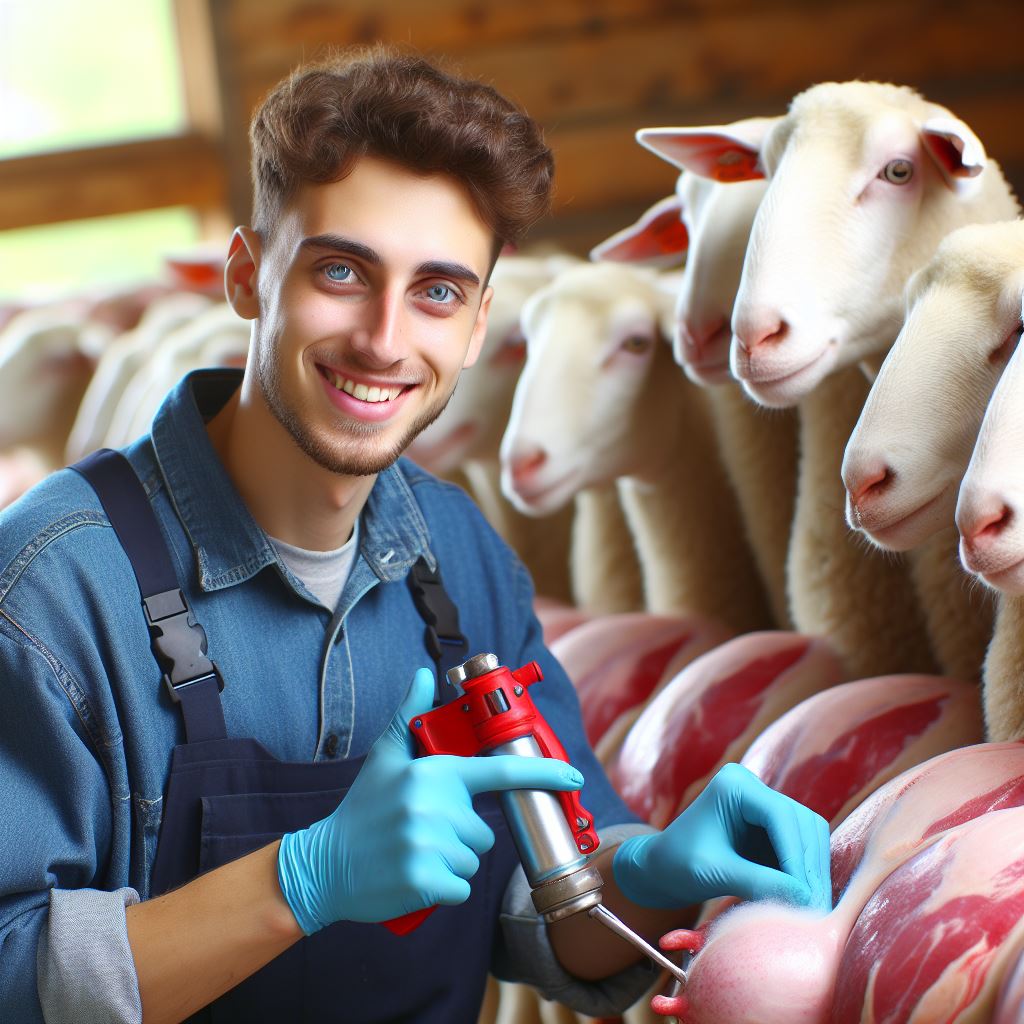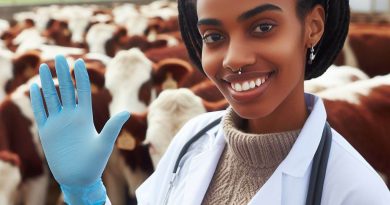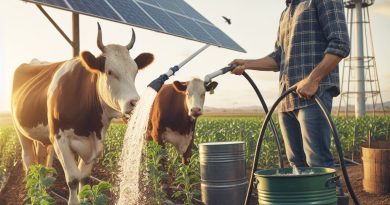Managing Reproduction in Sheep and Goats
Last Updated on January 23, 2024
Introduction
Let’s explore Managing Reproduction in Sheep and Goats.
A. Managing reproduction in sheep and goats is crucial for successful farming practices
Reproduction plays a vital role in the overall productivity and profitability of sheep and goat farming.
By effectively managing reproduction, farmers can maximize the number of offspring produced, enhance genetic traits, and improve the overall performance of their herds or flocks.
The significance of managing reproduction in sheep and goats cannot be overstated.
A well-planned and executed reproductive management program not only increases the potential for higher returns but also ensures the long-term sustainability of the enterprise.
B. Proper management of reproduction ensures optimal performance of the herd or flock
Improving reproductive efficiency involves various strategies, such as adjusting breeding schedules, implementing proper nutrition, and utilizing reproductive technologies.
By carefully synchronizing the breeding cycles, farmers can efficiently control reproduction and maximize the number of offspring produced within a specific timeframe.
Proper management of reproduction also entails monitoring the health and well-being of the animals.
Regular health checks, vaccinations, and disease prevention measures are essential to ensure successful breeding and healthy offspring.
Furthermore, reproductive management is crucial for maintaining and improving genetic traits in a herd or flock.
Selective breeding and controlled mating patterns can help enhance desirable characteristics, such as increased growth rates, improved meat quality, and better resistance to diseases.
General, effective management of reproduction is of utmost importance for sheep and goat farmers.
It not only ensures the success and profitability of their operations but also contributes to the overall sustainability and growth of the industry.
Understanding the Reproductive Cycle
A. Overview of the reproductive cycle in sheep and goats
Sheep and goats have similar reproductive cycles, consisting of key stages that drive their reproductive processes.
Understanding the reproductive cycle is essential for effectively managing and optimizing the reproduction process in sheep and goats.
By comprehending the key stages and factors that influence reproductive performance, this knowledge can be applied to improve herd management and breeding strategies.
B. Key stages in the reproductive cycle
The estrous cycle is a critical component of the reproductive cycle in sheep and goats.
It involves the cyclic changes that occur in the female’s reproductive system, leading to their ability to conceive and reproduce.
The length of the estrous cycle varies among individual animals, but it typically lasts between 15 to 19 days.
Mating and breeding are crucial steps in the reproductive cycle.
During the estrus phase of the estrous cycle, the female displays receptive behavior to attract the male.
Successful mating results in the male’s sperm fertilizing the female’s eggs, initiating pregnancy.
Pregnancy in sheep and goats lasts for about 145 to 155 days, depending on the species and individual characteristics.
Proper nutrition during this period is vital to support the development of the fetus and ensure the health of the pregnant female.
Parturition, also known as kidding in goats or lambing in sheep, is the culmination of the reproductive cycle.
The pregnant female gives birth to one or more offspring.
Adequate prepartum and postpartum care is crucial to ensure the health and survival of both the mother and her offspring.
C. Factors affecting reproductive performance
Several factors influence the reproductive performance of sheep and goats.
Nutrition plays a vital role, as poor-quality or imbalanced diets can lead to reduced fertility and reproductive disorders.
Providing a well-balanced diet that meets the animals’ nutritional requirements is crucial for optimal reproductive performance.
Genetics also significantly affect reproductive performance.
Breeding animals with desirable traits, such as higher fertility rates and better maternal instincts, can improve the overall reproductive efficiency of the herd or flock.
Age is another important factor to consider.
Young animals may not have fully developed reproductive systems, resulting in lower fertility rates.
Similarly, older animals might experience reduced reproductive performance due to age-related factors.
Lastly, the environment plays a significant role in reproductive efficiency.
Extreme weather conditions, inadequate housing, and high stress levels can negatively impact the animals’ reproductive health.
Providing a suitable and stress-free environment can enhance reproductive performance.
In general, understanding the reproductive cycle, its key stages, and the factors influencing reproductive performance is crucial for successful sheep and goat management.
By effectively managing nutrition, genetics, age, and environment, farmers and herders can optimize reproductive efficiency and ensure the overall health and productivity of their flocks.
Read: Beekeeping Health: Hive Disease Prevention
Preparing for Breeding Season
Breeding season is a crucial time for sheep and goat farmers.
To ensure successful reproduction, proper management and preparation are essential.
Here are key steps to prepare for breeding season:
A. Evaluating breeding stock
- Selection of healthy and fertile animals is crucial to producing strong offspring.
- Culling non-reproductive or poor-performing individuals helps maintain a high-quality breeding stock.
B. Nutrition management
- Providing proper feed and mineral supplementation ensures optimal nutrition for reproduction.
- Maintaining an optimal body condition score in breeding stock supports reproductive success.
C. Vaccinations and health checks
- Ensuring animals are disease-free and vaccinated reduces the risk of infections during mating.
- Identifying and treating any health issues early on improves the chances of successful breeding.
D. Reproductive synchronization techniques
- Implementing strategies to synchronize estrus, such as hormonal treatments, helps optimize breeding efficiency.
- Understanding the benefits and considerations of different synchronization methods is important for making informed decisions.
By following these steps, farmers can enhance their reproductive management practices, leading to better breeding outcomes and overall flock or herd productivity.
Read: Llama & Alpaca: Preventive Health Tips
Breeding Techniques
A. Natural Mating
Natural mating in sheep and goats has both advantages and limitations, influencing breeding decisions on farms.
- Behavioral Naturalness: Mimics the animals’ natural reproductive behaviors, reducing stress and promoting overall welfare.
- No Intervention Required: Minimal human interference, allowing animals to mate at their own pace, promoting natural selection.
- Genetic Diversity: Encourages genetic diversity within the flock or herd, maintaining a robust and adaptable population.
- Limited Control: Breeders have limited control over the timing and frequency of mating, affecting breeding schedules.
- Injury Risks: Natural mating can result in injuries, particularly in aggressive or inexperienced males, impacting overall animal health.
- Uncertain Conception: Breeding success is not guaranteed, and determining pregnancy may require additional monitoring or testing.
- Ewes/Does to Ram/Buck: Typically, a ratio of 25-30 females per ram or buck is recommended for optimal breeding efficiency.
- Age and Experience: Consider the age and experience of the males, ensuring they are physically capable and experienced breeders.
- Health Checks: Regular health assessments for males, ensuring their reproductive fitness and addressing any potential issues promptly.
Careful consideration of these factors ensures that natural mating is a successful and sustainable approach for sheep and goat reproduction on the farm.
B. Artificial Insemination (AI)
Artificial Insemination (AI) in sheep and goats revolutionizes reproduction, offering precise control and genetic improvement.
- Semen Collection: High-quality semen is collected from superior males, ensuring desirable genetic traits are passed on.
- Estrus Synchronization: Synchronization protocols align the reproductive cycles of females for efficient AI procedures.
- Insemination Procedure: Skilled technicians perform AI, depositing semen directly into the reproductive tract, maximizing conception rates.
- Genetic Advancements: AI facilitates the use of superior sires, accelerating genetic progress and enhancing flock or herd traits.
- Reduced Disease Transmission: Compared to natural mating, AI minimizes the risk of disease transmission between animals.
- Increased Productivity: AI allows for rapid genetic improvements, boosting flock or herd productivity and overall profitability.
Successful AI implementation requires proper planning, skilled technicians, and attention to animal well-being.
C. Embryo Transfer (ET)
Enhancing reproductive strategies in small ruminants, particularly sheep and goats, involves exploring the potential of Embryo Transfer (ET).
- ET Overview: Embryo Transfer involves retrieving fertilized embryos from a donor ewe or goat and implanting them into surrogate females.
- Applications: ET offers the potential to rapidly propagate superior genetics, improving flock or herd traits and overall productivity.
- Challenges: However, challenges include the need for skilled practitioners, costs, and the demanding synchronization of donor and recipient animals.
- Genetic Advancements: Advances in ET technology can accelerate the dissemination of desirable genetic traits, boosting the quality of small ruminant populations.
- Adaptation and Innovation: Overcoming challenges requires continual adaptation and innovation, making ET a dynamic aspect of modern small ruminant management.
Read: Rabbit Care: Preventing Common Ailments

Pregnancy and Care During Gestation
A. Monitoring pregnancy progress
During the gestation period, it is crucial to monitor the progress of pregnancy in sheep and goats.
Various methods can be employed to diagnose pregnancy.
Ultrasound scanning, palpation of the abdomen, and hormone testing can determine if an animal is pregnant.
These methods help ensure accurate analysis and appropriate care.
Determining gestational age is also essential.
It allows farmers to prepare for the upcoming birth and assess the development of the fetus.
By monitoring gestational age, farmers can anticipate the breeding season’s success and optimize management practices accordingly.
B. Nutrition and supplementation
Proper nutrition and supplementation play a vital role in ensuring the health of pregnant females.
Adjusting feed requirements helps meet the increased nutritional demands during gestation.
Providing a balanced diet rich in energy, protein, vitamins, and minerals is crucial for the development of the fetus and the overall well-being of the animal.
Mineral supplementation is of particular importance during pregnancy.
Minerals such as calcium, phosphorus, and selenium are crucial for proper fetal development and the prevention of deficiencies or imbalances.
Ensuring appropriate supplementation helps avoid complications and promotes healthy pregnancies with thriving offspring.
C. Housing and management practices
Housing and management practices are crucial in providing a conducive environment for pregnant animals.
Adequate space and comfortable housing are essential to minimize stress and promote natural behavior.
Proper ventilation, temperature control, and clean bedding contribute to a stress-free and healthy gestation period.
Managing stress during pregnancy is vital to prevent complications and ensure the well-being of both the mother and the fetus.
Implementing stress-reducing practices, such as minimizing handling and noise, helps create a calm environment.
Reducing exposure to potential risks, such as predators or aggressive animals, is also crucial to protecting pregnant females.
In general, monitoring pregnancy progress, ensuring proper nutrition and supplementation, and implementing suitable housing and management practices are essential for managing reproduction in sheep and goats.
By prioritizing the care and well-being of pregnant animals, farmers can optimize outcomes and promote healthy offspring.
Read: Breeding Tech: New Trends in Livestock Genetics
Parturition and Neonatal Care
In this section, we will explore the crucial aspects of managing reproduction specifically related to parturition and neonatal care in sheep and goats.
Being aware of the signs that indicate the approach of parturition is essential for successful outcomes.
A. Signs of approaching parturition
- Identifying physical and behavioral changes: Owners should closely observe their animals for any evident changes, such as udder enlargement, relaxation of the pelvic ligaments, and behavioral variations indicating restlessness or isolation.
- Preparing for a successful delivery: Creating a clean and comfortable birthing environment with adequate bedding and appropriate shelter minimizes stress and potential complications.
B. Assisting with difficult births
- Common birthing complications and interventions: Familiarizing oneself with common issues like malpresentation, dystocia, or prolonged labor helps determine the necessary interventions, which may include repositioning the fetus, administering lubrication, or gentle pulling.
- When to seek veterinary assistance: Owners should understand the importance of promptly seeking professional veterinary assistance when encountering difficulties beyond their expertise or resources, ensuring the safety of both the dam and offspring.
C. Lambing/Kidding management
- Proper care and hygiene for newborns: Providing a clean and warm environment, umbilical cord care, and ensuring sufficient colostrum intake are critical for the health and survival of the neonates.
- Vaccinations, nutrition, and early growth monitoring: Implementing an appropriate vaccination schedule, providing adequate nutrition, and closely monitoring the growth and development of the offspring are crucial for their long-term health and productivity.
By being attentive to the signs indicating the approaching parturition, owners can proactively prepare for successful deliveries.
Additionally, understanding the common birthing complications and appropriate interventions allows for timely and effective management.
It is important for owners to be aware of their limitations and seek professional veterinary assistance when necessary.
Timely intervention can significantly increase the chances of a positive outcome for both the dam and newborns.
Once the lambs/kids are born, providing them with proper care, nutrition, and a clean environment is vital for their growth and well-being.
Regular vaccinations and close monitoring contribute to their long-term health and productivity.
In essence, managing reproduction in sheep and goats requires careful attention to parturition and neonatal care.
Recognizing signs of approaching parturition, addressing birthing complications appropriately, and ensuring proper care for newborns all play vital roles in successful reproduction and overall flock/herd management.
Reproductive Monitoring and Record-Keeping
A. Importance of keeping accurate records
Keeping accurate records in sheep and goat reproduction management is of utmost importance.
It allows farmers and breeders to track breeding dates and monitor reproductive success and individual performance.
By utilizing tools and techniques for reproductive monitoring, such as heat detection methods and estrus synchronization monitoring, better outcomes can be achieved.
Additionally, incorporating technology for record-keeping provides efficient data management, but it also poses certain benefits and challenges.
Accurate record-keeping is essential for effective reproduction management.
One key aspect is tracking breeding dates.
Knowing the specific dates when breeding occurred helps determine the expected lamb or kid due dates, allowing farmers to plan and prepare accordingly.
It also helps identify any issues or inefficiencies in the breeding process, enabling improvements for future breeding seasons.
Furthermore, monitoring reproductive success and individual performance is crucial for maintaining a healthy and productive flock or herd.
Keeping records of pregnancy rates, lambing or kidding percentages, and survival rates provides valuable information about the overall reproductive performance.
By tracking these metrics, farmers can identify any potential problems and take appropriate measures to enhance the reproductive outcomes of their animals.
B. Tools and techniques for reproductive monitoring
There are various tools and techniques available for reproductive monitoring in sheep and goats.
Heat detection methods, such as visual observation, Kamar patches, or electronic heat detectors, aid in determining the optimal time for breeding.
By closely observing heat signs, farmers can ensure that mating occurs during the female’s fertile period, increasing the chances of successful reproduction.
Estrus synchronization monitoring is another valuable technique.
It involves manipulating the reproductive cycle of the females to synchronize them, enabling more efficient breeding.
Hormonal treatments or the use of artificial insemination techniques can be employed to control estrus and ensure uniformity in breeding.
By closely monitoring the synchronization process, breeders can maximize the number of pregnancies within a specific time frame.
C. Utilizing technology for efficient record-keeping
Advancements in technology have revolutionized record-keeping practices.
Digital tools and software have been developed specifically for reproductive data management in the sheep and goat industry.
These tools allow farmers and breeders to input, store, and analyze large amounts of reproductive data, providing valuable insights.
They streamline the record-keeping process, saving time and reducing the chances of errors or loss of important information.
However, incorporating technology into record-keeping also presents its own set of challenges.
It requires initial investment in hardware, software, and training.
Additionally, ensuring data security and privacy is crucial when using digital tools.
Regular backups and implementing proper security measures are essential to protect sensitive reproductive data.
Moreover, not all farmers may be comfortable using technology or have access to reliable internet connectivity, limiting their ability to fully leverage digital record-keeping tools.
All in all, reproductive monitoring and accurate record-keeping are vital components in sheep and goat reproduction management.
Tracking breeding dates, monitoring reproductive success, and individual performance help optimize outcomes.
By utilizing tools and techniques like heat detection and estrus synchronization monitoring, breeders can enhance reproductive efficiency.
Embracing technology for efficient record-keeping offers numerous benefits, but challenges need to be addressed to ensure the effective use of digital tools in managing reproductive data.
Conclusion
A. Recap of key points discussed
In this section, we focused on managing reproduction in sheep and goats.
We discussed the importance of understanding the reproductive cycle, detecting estrus, and implementing effective breeding strategies.
We also explored the significance of nutritional management, proper hygiene, and vaccination protocols in ensuring optimal reproductive efficiency.
Additionally, we addressed the use of reproductive technologies like artificial insemination and embryo transfer.
B. Emphasizing the importance of effective reproduction management
It is evident that proper reproduction management is crucial for maintaining a healthy and productive herd or flock.
By implementing the discussed strategies, farmers can optimize breeding outcomes, increase flock size, and enhance overall profitability.
Efficient reproduction management not only ensures a steady supply of replacement breeding animals but also supports genetic improvement and disease prevention in the flock or herd.
C. Encouraging continuous learning and improvement in herd/flock management
As the field of animal husbandry evolves, it is essential for sheep and goat farmers to stay updated with advancements in reproductive technologies and management practices.
Continuous learning, attending workshops, and engaging with industry experts can provide valuable insights and help improve herd or flock management, ultimately leading to better reproductive performance and long-term sustainability.


